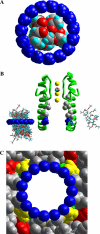KvAP-based model of the pore region of shaker potassium channel is consistent with cadmium- and ligand-binding experiments
- PMID: 15908577
- PMCID: PMC1366588
- DOI: 10.1529/biophysj.105.062240
KvAP-based model of the pore region of shaker potassium channel is consistent with cadmium- and ligand-binding experiments
Abstract
Potassium channels play fundamental roles in excitable cells. X-ray structures of bacterial potassium channels show that the pore-lining inner helices obstruct the cytoplasmic entrance to the closed channel KcsA, but diverge in widely open channels MthK and KvAP, suggesting a gating-hinge role for a conserved Gly in the inner helix. A different location of the gating hinge and a narrower open pore were proposed for voltage-gated Shaker potassium channels that have the Pro-473-Val-Pro motif. Two major observations back the proposal: cadmium ions lock mutant Val-476-Cys in the open state by bridging Cys-476 and His-486 in adjacent helices, and cadmium blocks the locked-open double mutant Val-474-Cys/Val-476-Cys by binding to Cys-474 residues. Here we used molecular modeling to show that the open Shaker should be as wide as KvAP to accommodate an open-channel blocker, correolide. We further built KvAP-, MthK-, and KcsA-based models of the Shaker mutants and Monte-Carlo-minimized them with constraints Cys-476-Cd(2+)-His-486. The latter were consistent with the KvAP-based model, causing a small-bend N-terminal to the Pro-473-Val-Pro motif. The constraints significantly distorted the MthK-based structure, making it similar to KvAP. The KcsA structure resisted the constraints. Two Cd(2+) ions easily block the locked-open KvAP-based model at Cys-474 residues, whereas constraining a single cadmium ion to four Cys-474 caused large conformational changes and electrostatic imbalance. Although mutual disposition of the voltage-sensor and pore domains in the KvAP x-ray structure is currently disputed, our results suggest that the pore-region domain retains a nativelike conformation in the crystal.
Figures







Similar articles
-
Models of the structure and voltage-gating mechanism of the shaker K+ channel.Biophys J. 2004 Oct;87(4):2116-30. doi: 10.1529/biophysj.104.040618. Biophys J. 2004. PMID: 15454416 Free PMC article.
-
Conserved gating hinge in ligand- and voltage-dependent K+ channels.Biochemistry. 2004 Oct 26;43(42):13242-7. doi: 10.1021/bi048377v. Biochemistry. 2004. PMID: 15491131
-
Intracellular gate opening in Shaker K+ channels defined by high-affinity metal bridges.Nature. 2004 Apr 22;428(6985):864-8. doi: 10.1038/nature02468. Nature. 2004. PMID: 15103379
-
Structural models of the transmembrane region of voltage-gated and other K+ channels in open, closed, and inactivated conformations.J Struct Biol. 1998;121(2):263-84. doi: 10.1006/jsbi.1998.3962. J Struct Biol. 1998. PMID: 9615442 Review.
-
Structural organization of the voltage sensor in voltage-dependent potassium channels.Novartis Found Symp. 2002;245:178-90; discussion 190-2, 261-4. Novartis Found Symp. 2002. PMID: 12027007 Review.
Cited by
-
State-dependent inter-repeat contacts of exceptionally conserved asparagines in the inner helices of sodium and calcium channels.Pflugers Arch. 2015 Feb;467(2):253-66. doi: 10.1007/s00424-014-1508-0. Epub 2014 Apr 15. Pflugers Arch. 2015. PMID: 24728659
-
Analysis of inter-residue contacts reveals folding stabilizers in P-loops of potassium, sodium, and TRPV channels.Eur Biophys J. 2016 May;45(4):321-9. doi: 10.1007/s00249-015-1098-6. Epub 2015 Dec 8. Eur Biophys J. 2016. PMID: 26646260
-
Probing the cavity of the slow inactivated conformation of shaker potassium channels.J Gen Physiol. 2007 May;129(5):403-18. doi: 10.1085/jgp.200709758. Epub 2007 Apr 16. J Gen Physiol. 2007. PMID: 17438120 Free PMC article.
-
Monte Carlo-energy minimization of correolide in the Kv1.3 channel: possible role of potassium ion in ligand-receptor interactions.BMC Struct Biol. 2007 Jan 29;7:5. doi: 10.1186/1472-6807-7-5. BMC Struct Biol. 2007. PMID: 17261195 Free PMC article.
-
Side chain flexibility and the pore dimensions in the GABAA receptor.J Comput Aided Mol Des. 2016 Jul;30(7):559-67. doi: 10.1007/s10822-016-9929-9. Epub 2016 Jul 26. J Comput Aided Mol Des. 2016. PMID: 27460059
References
-
- Doyle, D. A., J. Morais Cabral, R. A. Pfuetzner, A. Kuo, J. M. Gulbis, S. L. Cohen, B. T. Chait, and R. MacKinnon. 1998. The structure of the potassium channel: molecular basis of K+ conduction and selectivity. Science. 280:69–77. - PubMed
-
- Jiang, Y., A. Lee, J. Chen, M. Cadene, B. T. Chait, and R. MacKinnon. 2002. Crystal structure and mechanism of a calcium-gated potassium channel. Nature. 417:515–522. - PubMed
-
- Jiang, Y., A. Lee, J. Chen, V. Ruta, M. Cadene, B. T. Chait, and R. MacKinnon. 2003. X-ray structure of a voltage-dependent K+ channel. Nature. 423:33–41. - PubMed
-
- Jiang, Y., A. Lee, J. Chen, M. Cadene, B. T. Chait, and R. MacKinnon. 2002. The open pore conformation of potassium channels. Nature. 417:523–526. - PubMed
-
- Luzhkov, V. B., J. Nilsson, P. Arhem, and J. Aqvist. 2003. Computational modelling of the open-state Kv 1.5 ion channel block by bupivacaine. Biochim. Biophys. Acta. 1652:35–51. - PubMed
Publication types
MeSH terms
Substances
LinkOut - more resources
Full Text Sources

